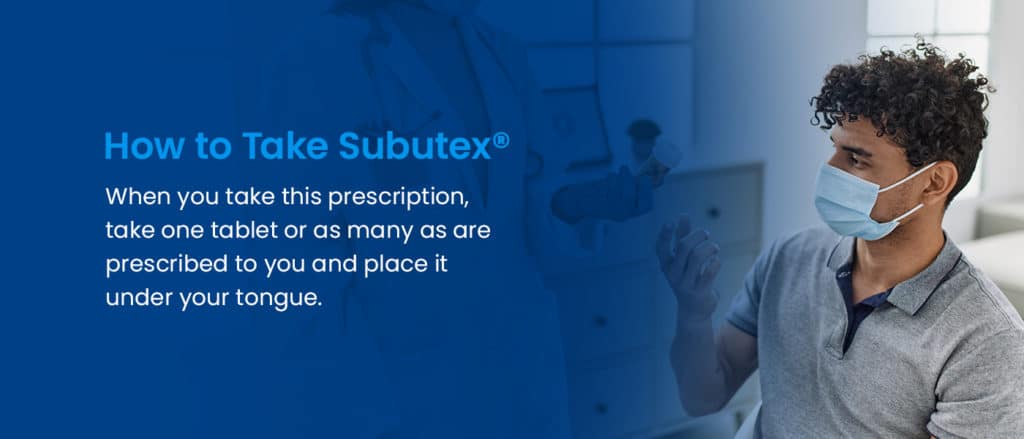
Suboxone® or Subutex®
To understand the difference between Suboxone® and Subutex®, you must first understand the difference between methadone and buprenorphine. Before the year 2000 the primary drug used to treat those with the disease of opioid addiction was methadone. In 2000, however, an additional medicine to treat opioid addiction called buprenorphine was approved by the FDA.
In combination with counseling and behavioral therapy, buprenorphine has proven to be a superior medication to include in a comprehensive treatment plan. Because of its unique properties, it can lower misuse potential, decrease withdrawal symptoms and protect users in case of an overdose. It’s in both medications, making Suboxone® and Subutex® opiate blockers, which prevent opiates from producing the desired effect in the body.
While methadone is a Schedule II substance, buprenorphine is a Schedule III substance. Schedule III has a lower potential for abuse than Schedule II. As a result of the FDA approval, buprenorphine is an alternate treatment medication for opioid addiction alongside methadone. If buprenorphine is the medicine you and your doctor decide is right for you then you might hear about the two most common forms of buprenorphine which are Suboxone® and Subutex®.
The Similarities Between Suboxone® and Subutex®
Both Suboxone® and Subutex® are medications used in treatment to help individuals with the disease of opioid addiction. Suboxone® and Subutex® interact with the same receptors in the brain that are affected by opioids, such as heroin, but without causing the euphoria that results from opioid use. Because of this, individuals who take Suboxone® or Subutex® under professional supervision can live their lives without experiencing the cravings or withdrawals that would normally occur in the absence of opioids.

The Difference Between Suboxone® and Subutex®
The main difference between Suboxone® and Subutex® is that Suboxone® contains naloxone and Subutex® doesn’t. The naloxone component of Suboxone® is not active when absorbed in the mouth. Naloxone is mixed with buprenorphine to prevent misuse.
Normally naloxone is a medication designed to rapidly reverse an opioid overdose. It is an opioid antagonist—meaning that it binds to opioid receptors and can reverse and block the effects of other opioids. It can quickly restore normal respiration to a person whose breathing has slowed or stopped as a result of overdosing with heroin or prescription opioid pain medications. Suboxone® contains both buprenorphine and naloxone while Subutex® only contains buprenorphine.
Which One Is Right for Me?
Together you and your provider should decide which formulation is appropriate. Both Suboxone® and Subutex® significantly decrease cravings, combat physical symptoms of withdrawal, and help you to stay the course in addiction treatment.
People struggling with opioid addiction have noted either formulation is effective in treatment. They don’t feel the kind of emotional and physical distress of withdrawal that makes recovery so difficult. Either formulation makes it more difficult or impossible to feel the effects of other opioids, making relapse less likely. Patients can focus on other aspects of their treatment.
Suboxone® is the preferred formulation for treatment. Typically the choice between the two formulations is based on other factors. If a patient is pregnant or has a documented allergy to naloxone, Subutex® is chosen. No matter the formulation taking the first steps to overcome a dependency on opioids and getting treatment for the disease of addiction is HUGE. To make sure you are getting the best care possible, talk to your healthcare professional and together you can determine which of these medications will be the best for you.

How to Take Subutex®
When you’re prescribed Subutex®, you’ll receive a number of tablets, depending on your dosage allotment. You should take the medication exactly as your doctor prescribes, but in general, you’ll be expected to take it once a day for the first few days of your detox. Taking it soon after symptoms start is the best time. Although it may be tempting to start before your symptoms appear to keep from feeling the worst of things, this can actually bring on withdrawal symptoms before their time and cause you more discomfort.
When you take this prescription, take one tablet or as many as are prescribed to you and place it under your tongue. Let it dissolve completely before swallowing — it usually takes between five and 10 minutes. Swallowing or chewing the medication as opposed to putting it under your tongue will affect its potency and effects.
Once it’s dissolved, take a sip of water and swish it around your mouth so the medication mixes with it, then swallow. The water will prevent teeth and mouth issues. You should also avoid brushing your teeth for an hour after taking the medication. For the best effects, take this medication at the same time every day and use the proper dosage for you.
Do not try to inject buprenorphine to take it in any other way than how your doctor tells you to. This action is dangerous and can cause intense withdrawal symptoms, particularly dizziness, headaches and constipation. You’ll likely only be taking Subutex® for a few days before switching to long-term Suboxone®.
How to Take Suboxone®
There are a few different ways you might be prescribed to take Suboxone. Again, your medication will depend on your specific medical history and needs, so type and dosage can vary from person to person. The FDA has approved three forms of absorption:
- Sublingual tablets: Similar to Subutex® tablets, these pills are meant to be placed under the tongue until they dissolve.
- Sublingual films: This form works the same way as the tablets by going under the tongue and dissolving, but it looks like a patch.
- Buccal films: Instead of placing this film under the tongue to dissolve, you’ll put it between your cheek and gums.
Although side effects aren’t common with Suboxone®, they can occur. Aside from rare allergic reactions, you may experience excessive sweating, fatigue, back pain, depression, nausea or constipation. You may also notice a burning tongue or redness in your mouth. More serious reactions can include breathing problems, dependence and liver damage. The best way to prevent serious side effects is to take your prescription only as directed and contact your prescriber if you start to feel off.
Get in Touch With AppleGate Recovery
If you’re ready to take the next step by seeking recovery and medication-assisted treatment for opioid addiction, the team at AppleGate Recovery can help. We look forward to hearing from you and guiding you on your journey to better health.
People Also Read:

Contact AppleGate Recovery Today
If opioid addiction is impacting your life or the life of someone you care about, reach out to our treatment center. We are here to provide the support and care you need to take the first step toward recovery.
Call 888.488.5337
